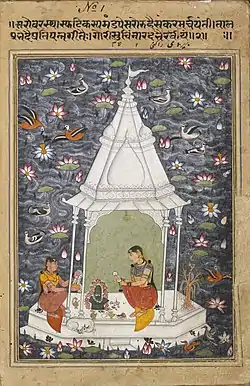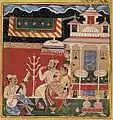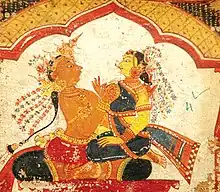Ragamala paintings
Ragamala paintings are a form of Indian miniature painting, a set of illustrative paintings of the Ragamala or "Garland of Ragas", depicting variations of the Indian musical modes called ragas. They stand as a classical example of the amalgamation of art, poetry and classical music in medieval India.

Ragamala paintings were created in most schools of Indian painting, starting in the 16th and 17th centuries, and are today named accordingly as Pahari Ragamala, Rajasthan or Rajput Ragamala, Deccan Ragamala, and Mughal Ragamala.
Also it originated in Rajasthan.
In these painting each raga is personified by a colour, mood, a verse describing a story of a hero and heroine (nayaka and nayika), it also elucidates the season and the time of day and night in which a particular raga is to be sung; and finally most paintings also demarcate the specific Hindu deities attached with the raga, like Bhairava or Bhairavi to Shiva, Sri to Devi etc. The paintings depict not just the Ragas, but also their wives, (raginis), their numerous sons (ragaputra) and daughters (ragaputri).[1]
The six principal ragas present in the Ragamala are Bhairava, Deepak, Sri, Malkaunsa, Megha and Hindola and these are meant to be sung during the six seasons of the year – summer, monsoon, autumn, early winter, winter and spring.
History

Sangita Ratnakara is an important 12th century CE treatise on the classification of Indian Ragas, which for the first time mentions the presiding deity of each raga.[2] From the 14th century onwards, they were described in short verses in Sanskrit, for dhyana, 'contemplation', and later depicted in a series of paintings, called the Ragamala paintings.[3] Some of the best available works of Ragamala are from the 16th and 17th centuries, when the form flourished under royal patronage,[4] though by the 19th century, it gradually faded.
Extant works
.jpg.webp)
In 1570, Kshemakarna, a priest of Rewa in Central India, compiled a poetic text on the Ragamala in Sanskrit, which describes six principal Ragas—Bhairava, Malakoshika, Hindola, Deepak, Shri, and Megha—each having five Raginis and eight Ragaputras, except Raga Shri, which has six Raginis and nine Ragaputras, thus making a Ragamala family of 86 members[5]
Most of the extant works of Ragamala are from Deccan style, where Ibrahim Adil Shah II of Bijapur, was himself also a fine painter and illustrator, though some Rajput style also exist of which the work of an artist of the 'Chawand' (a part of Mewar) school of painting, Sahibdin, whose Ragamala (musical modes) series dated 1628, are now in National Museum of India[6]
Ragamala sets discovered in Odisha are in the Pattachitra style, based on the ragas of Odissi music and show distinct iconography and raga groups from other regions.[7]
The Ragas in Ragamala
Six are male (parent) ragas; the thirty raginis are their wives and the remaining forty-eight are their sons. These are listed is as follows:
- (1) Parent Raga: Bhairav raga
Wives: Bhairavi, Bilawali, Punyaki, Bangli, Aslekhi. Sons: Pancham, Harakh, Disakh, Bangal, Madhu, Madhava, Lalit, Bilaval.
- (2) Parent Raga: Malkaus raga
Wives: Gaundkari, Devagandhari, Gandhari, Seehute, Dhanasri. Sons: Maru, Mustang, Mewara, Parbal, Chand, Khokhat, Bhora, Nad.
- (3) Parent Raga: Hindol raga
Wives: Telangi, Devkari, Basanti, Sindhoori, Aheeri. Sons: Surmanand, Bhasker, Chandra-Bimb, Mangalan, Ban, Binoda, Basant, Kamoda.
- (4) Parent Raga: Deepak raga
Wives: Kachheli, Patmanjari, Todi, Kamodi, Gujri. Sons: Kaalanka, Kuntal, Rama, Kamal, Kusum, Champak, Gaura, Kanra [36].
- (5) Parent Raga: Sri raga
Wives: Bairavi, Karnati, Gauri, Asavari, Sindhavi. Sons: Salu, Sarag, Sagra, Gaund, Gambhir, Gund, Kumbh, Hamir.
- (6) Parent Raga: Megh raga
Wives: Sorath, Gaundi-Malari, Asa, Gunguni, Sooho. Sons: Biradhar, Gajdhar, Kedara, Jablidhar, Nut, Jaldhara, Sankar, Syama.
Gallery
 Bhairavi Ragini. Possibly Mewar, c. 1550. Victoria and Albert Museum
Bhairavi Ragini. Possibly Mewar, c. 1550. Victoria and Albert Museum
 Malkausik Raga, folio from the Chunar Ragamala, dated February 24, 1591. Private collection, New York
Malkausik Raga, folio from the Chunar Ragamala, dated February 24, 1591. Private collection, New York Dipak Raga, folio from the Chawand Ragamala by Nasiruddin. Mewar, 1605. G.K. Kanoria Collection
Dipak Raga, folio from the Chawand Ragamala by Nasiruddin. Mewar, 1605. G.K. Kanoria Collection Ragini Bhairavi. Bundi, c. 1625. Allahabad Museum
Ragini Bhairavi. Bundi, c. 1625. Allahabad Museum Lalit Ragini, folio from the Ragamala painted by Sahibdin. Mewar, 1628. National Museum, New Delhi
Lalit Ragini, folio from the Ragamala painted by Sahibdin. Mewar, 1628. National Museum, New Delhi_001.jpg.webp) Hindola Raga. Malwa, c. 1650. Bharat Kala Bhavan
Hindola Raga. Malwa, c. 1650. Bharat Kala Bhavan
 Vasanti Ragini. Bilaspur, c. 1710. Metropolitan Museum of Art
Vasanti Ragini. Bilaspur, c. 1710. Metropolitan Museum of Art Raga Madhava, by the 2nd Master of the Shangri Ramayana series. Probably Bahu, c. 1720. Rietberg Museum
Raga Madhava, by the 2nd Master of the Shangri Ramayana series. Probably Bahu, c. 1720. Rietberg Museum Ragini Madhumadhavi, by Jay Krishna. Malpura, c. 1756. Rietberg Museum
Ragini Madhumadhavi, by Jay Krishna. Malpura, c. 1756. Rietberg Museum Ragini Todi. Ascribed to a Master of the Second Generation after Nainsukh, c. 1825-30. Government Museum and Art Gallery, Chandigarh
Ragini Todi. Ascribed to a Master of the Second Generation after Nainsukh, c. 1825-30. Government Museum and Art Gallery, Chandigarh Two lovers (possibly Kodaba Raga). Pigment on cloth, in the technique closely resembling that used in Odishan pattachitras. Odisha, circa 1850. Private collection
Two lovers (possibly Kodaba Raga). Pigment on cloth, in the technique closely resembling that used in Odishan pattachitras. Odisha, circa 1850. Private collection
References
- Ragamala Art Gallery of New South Wales.
- "Ragamala Paintings".
- Ragamala – wyastone.co.uk. Archived 26 May 2008 at the Wayback Machine
- Bhairavi Ragini – britishmuseum.org.
- "Bernoulli,* Daniel – Dictionary definition of Bernoulli,* Daniel – Encyclopedia.com: FREE online dictionary".
- Ragamala Britannica.com.
- Patnaik, Kabichandra Dr. Kalicharan (1966). Raga-Chitra. Odisi Kala Prakash.
Further reading
- Moghul Ragamala: Painted Indian Melodies and the Poetry of Kshemakarna, by Ludwig V. Habighorst. Koblenz: Ragaputra Edition, 2006.
- Ragamala Paintings from India, the collection of Claudio Moscatelli, by Glynn, Skelton, Dallapiccola. Philip Wilson Publishers in association with Dulwich Picture Gallery Museum and Art Gallery London 2011